
The Dutch House is a late-17th-century house in New Castle in the U.S. state of Delaware. Built during New Castle's colonial period, the house currently serves a museum under the management of the New Castle Historical Society.

The Dutch House is a late-17th-century house in New Castle in the U.S. state of Delaware. Built during New Castle's colonial period, the house currently serves a museum under the management of the New Castle Historical Society.
The Dutch House was built in the late 17th century, between 1664 and 1682. [1] It is often contested whether the Dutch House or the Ryves Holt House is the oldest home in the state of Delaware. [2] Although the home is recorded as being built for a Dutch family, it was built using English methods during the English occupation (1663–1673) of the colony; this was not discovered until the home was undergoing restoration. [3] The home is located across the street from the New Castle town green, and its doorstep is located below street level on account of the street's having been raised in the mid-18th century. The home was privately owned until 1937, when it was restored and put under the management of the New Castle Historical Society. [2] [3] [1]

New Sweden was a Swedish colony along the lower reaches of the Delaware River in America from 1638 to 1655, established during the Thirty Years' War when Sweden was a great military power. New Sweden formed part of the Swedish efforts to colonize the Americas. Settlements were established on both sides of the Delaware Valley in the region of Delaware, New Jersey, Maryland, and Pennsylvania, often in places where Swedish traders had been visiting since about 1610. Fort Christina in Wilmington, Delaware, was the first settlement, named after the reigning Swedish monarch. The settlers were Swedes, Finns, and a number of Dutch. New Sweden was conquered by the Dutch Republic in 1655 during the Second Northern War and incorporated into the Dutch colony of New Netherland.

Lewes is an incorporated city on the Delaware Bay in eastern Sussex County, Delaware, United States. According to the 2010 census, the population is 2,747. Along with neighboring Rehoboth Beach, Lewes is one of the principal cities of Delaware's rapidly growing Cape Region. The city lies within the Salisbury, Maryland–Delaware Metropolitan Statistical Area. Lewes proudly claims to be "The First Town in The First State."
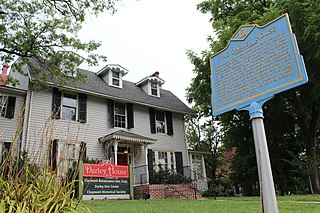
Claymont is a census-designated place (CDP) in New Castle County, Delaware, United States. The estimated 2017 population of the 19703 ZIP code, which Claymont encompasses, was 15,292.

New Castle is a city in New Castle County, Delaware, United States, six miles (10 km) south of Wilmington, and situated on the Delaware River. According to the 2010 Census, the population of the city is 5,285.
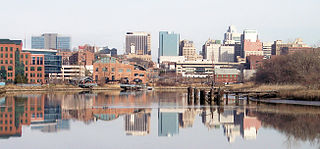
Wilmington is the largest and most populous city in the U.S. state of Delaware. The city was built on the site of Fort Christina, the first Swedish settlement in North America. It lies at the confluence of the Christina River and Brandywine River, near where the Christina flows into the Delaware River. It is the county seat of New Castle County and one of the major cities in the Delaware Valley metropolitan area. Wilmington was named by Proprietor Thomas Penn after his friend Spencer Compton, Earl of Wilmington, who was prime minister during the reign of George II of Great Britain.

The Hagley Museum and Library is a nonprofit educational institution in unincorporated New Castle County, Delaware, near Wilmington. Covering more than 235 acres (95 ha) along the banks of the Brandywine Creek, the museum and grounds include the first du Pont family home and garden in the United States, the powder yards, and a 19th-century machine shop. On the hillside below the mansion lies a Renaissance-revival garden, with terraces and statuary, created in the 1920s by Louise Evalina du Pont Crowninshield (1877–1958).

Delaware Colony in the North American Middle Colonies consisted of land on the west bank of the Delaware River Bay. In the early 17th century the area was inhabited by Lenape and possibly the Assateague tribes of Native Americans. The first European settlers were Swedes, who established the colony New Sweden at Fort Christina at present day Wilmington, in 1638. The Dutch captured the colony in 1655 and annexed it to New Netherland to the north. The English took control from the Dutch in 1664, and in 1682, William Penn, the Quaker Proprietor of Pennsylvania to the north, leased "the three lower counties on the Delaware River" from James, the Duke of York.
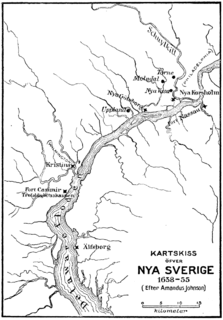
Fort Nya Elfsborg was a fortification and settlement established as a part of New Sweden. Built in 1643 and named after the Älvsborg Fortress off Gothenburg, Fort Nya Elfsborg was located on the New Jersey side of the Delaware River, between present day Salem and Alloway Creek.

The Block House is a historic building located off Naamans Road in Claymont, Delaware. The Block House is believed to be the only structure remaining of original settlement on Naamans Creek.

The Castle of Good Hope known locally as the Castle or Cape Town Castle is a bastion fort built in the 17th century in Cape Town, South Africa. Originally located on the coastline of Table Bay, following land reclamation the fort is now located inland. In 1936 the Castle was declared a historical monument and following restorations in the 1980s it is considered the best preserved example of a Dutch East India Company fort.

Fort Casimir or Fort Trinity was a Dutch fort in the seventeenth-century colony of New Netherland. It was located on a no-longer existing barrier island at the end of Chestnut Street in what is now New Castle, Delaware.
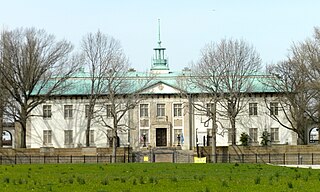
The American Swedish Historical Museum is the oldest Swedish-American museum in the United States. It is located in Franklin Delano Roosevelt Park in South Philadelphia, on part of a historic 17th-century land grant originally provided by Queen Christina of Sweden to settlers of New Sweden.

Dutch Colonial is a style of domestic architecture, primarily characterized by gambrel roofs having curved eaves along the length of the house. Modern versions built in the early 20th century are more accurately referred to as "Dutch Colonial Revival", a subtype of the Colonial Revival style.
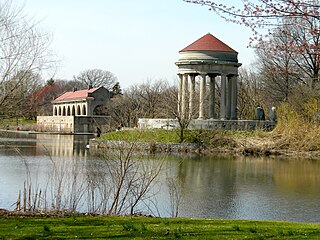
Franklin Delano Roosevelt (FDR) Park is an aesthetically designed park located along the Delaware River in the southernmost point of South Philadelphia, Pennsylvania, comprising some 348 acres (1.41 km2) which includes a 146-acre (0.59 km2) golf course, about 125 acres (0.51 km2) of buildings, roadways, pathways for walking, landscaped architecture, and a variety of picnic and recreation areas placed within about 77 acres (310,000 m2) of natural lands including ponds and lagoons.

Zwaanendael or Swaanendael was a short-lived Dutch colonial settlement in Delaware. It was built in 1631. The name is archaic Dutch for "swan valley." The site of the settlement later became the town of Lewes, Delaware.

Fort Nassau was a factorij in New Netherland between 1627–1651 located at the mouth of Big Timber Creek at its confluence with the Delaware River. It was the first known permanent European-built structure in what would become the state of New Jersey. The creek name is a derived from the Dutch language Timmer Kill as recorded by David Pietersen de Vries in his memoirs of his journey of 1630–1633. The Delaware Valley and its bay was called the "South River" ; the "North River" of the colony was the Hudson River. The factorij was established for the fur trade, mostly in beaver pelts, with the indigenous populations of Susquehannock, who spoke an Iroquoian language, and the Lenape, whose language was of the Algonquian family. They also wanted to retain a physical claim to the territory.

The Delaware Historical Society began in 1864 as an effort to preserve documents from the Civil War. Since then, it has expanded into a statewide historical institution with several buildings, including Old Town Hall and the Delaware History Museum, in Wilmington and the historic Read House & Gardens in New Castle.

First State National Historical Park is a National Park Service unit which lies primarily in the state of Delaware but which extends partly into Pennsylvania in Chadds Ford. Initially created as First State National Monument by President Barack Obama under the Antiquities Act on March 25, 2013, the park was later redesignated as First State National Historical Park by Congress.
The New Sweden Farmstead Museum was an open-air museum in Bridgeton, New Jersey, United States. A recreation of a 17th-century Swedish farmstead, it was located in City Park, and served as a historical remembrance of the history of the Swedish and Finnish people who arrived as part of the colony of New Sweden in early America. Originally opened in 1988, it operated as a living museum for many years. As funding and attendance declined, the log buildings at the complex fell into disrepair, requiring it to close.

St. Paul's Church is an Episcopal church founded in 1702 in Chester, Pennsylvania. The church is a part of the Episcopal Diocese of Pennsylvania. It is located at 301 East 9th Street and is an active worship center.
Coordinates: 39°39′39″N75°33′48″W / 39.6609°N 75.5634°W